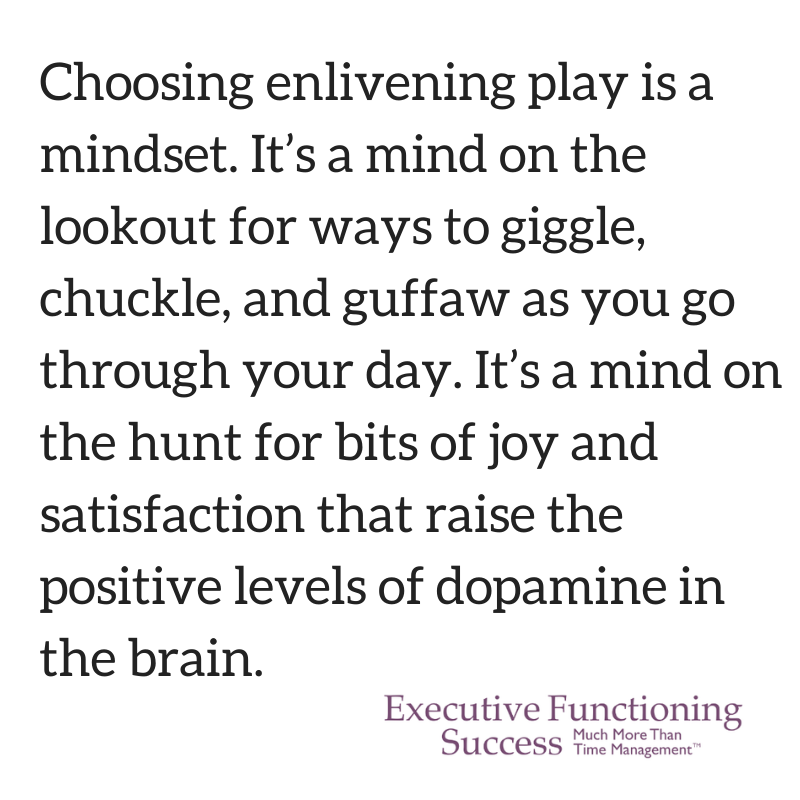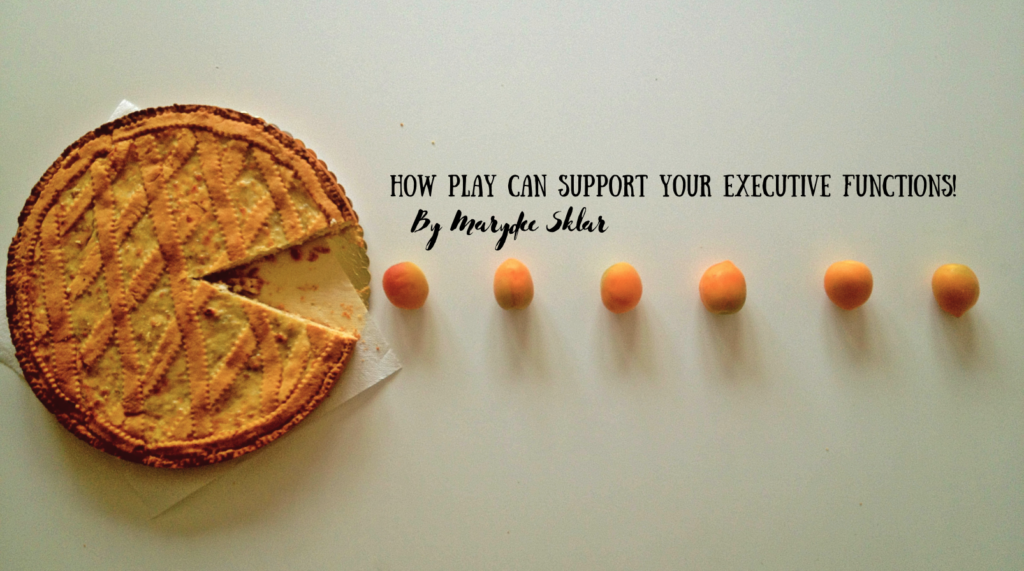As I look out my window at a gray Portland sky, it seems to mirror how many people are feeling in general these days. After an exhausting 2020, people are still struggling with their executive functions in these uncertain times. So here is my question for you: What have you done to play today?
Play? Yes, play. Now you may be thinking: “but Marydee, isn’t “play” the opposite of time management and productivity? Doesn’t play interfere with getting things done?”
The answer is no, you just have to be aware of the different kinds of play: enlivening play or escapism play. They are two very different things.
Escapism play is, well, a way to escape from our responsibilities. But enlivening play is just the opposite. Choosing enlivening play is a mindset. It’s a mind on the lookout for ways to giggle, chuckle, and guffaw as you go through your day. It’s a mind on the hunt for bits of joy and satisfaction that raise the positive levels of dopamine in the brain. It’s deciding to be sunny on a gray day; deciding to have as much fun as possible despite our responsibilities! This kind of mindset is incredibly supportive to the executive functions of the brain.
Recently, I decided that to combat the continuing uncertainty and challenges of my own life, I would make “play” my focus word for 2021. (You might have heard me talk about planning for fun as a means to encourage the brain to engage in the executive function future planning! This is a similar concept). To my delight, play is turning out to be a critical component for improving executive functioning in both my clients and myself. As a result, I’ve seen that lots of my clients (and employees) have embraced play as well.
Here are stories of two clients who have recently inspired me, and I hope they inspire you too.
 An eighth-grade Seeing My Time client was really struggling with online school and emotional control. When he showed up for his Zoom session he would only show me his shoulder. Dad’s exhausted face told the whole story. It took about 20 minutes for the student to show his face. Then we got down to work, searching for any tiny little thing he’d done that was positive. I stressed that our brain’s neurons love the positive chemicals that activate our neurons when we are having fun and celebrating successes. When he admitted that he had actually turned in one hard assignment on time, I jumped on it.
An eighth-grade Seeing My Time client was really struggling with online school and emotional control. When he showed up for his Zoom session he would only show me his shoulder. Dad’s exhausted face told the whole story. It took about 20 minutes for the student to show his face. Then we got down to work, searching for any tiny little thing he’d done that was positive. I stressed that our brain’s neurons love the positive chemicals that activate our neurons when we are having fun and celebrating successes. When he admitted that he had actually turned in one hard assignment on time, I jumped on it.
“Yay! Happy Dance!” I practically shouted as I hammed it up, hands in the air, pointy fingers moving up and down with my goofy shoulder movements. I had a giant (sincere) smile on my face. “Come on!” I said. “Do a little happy dance! You deserve it!” Reluctantly he mirrored my dance in a subdued 8th grader way. Finally, a tiny smile appeared on his face. “See? Doesn’t that smile feel good! You’ve got happy neurons!”
Relaxing his shoulders, and putting his hands down, he said, “Is this like having a brain party?”
I burst out laughing. “Yes! It’s a brain party!”
The next week when he checked in, he wrote that he’d been better at controlling his moods. “Fantastic!” popped out of my mouth. “How did you do that?” He gave me a little grin and did his version of a happy dance. “Have you been having brain parties?” His grin widened and his eyes sparkled as he nodded his head. Dad was grinning too. What little actions can you celebrate to have your own brain parties?
Pac-Man Play for the Win
My other inspiring story of play is an adult client who has been struggling at work. Her career requires attention to detail and a fair number of routine-oriented tasks, and she was concerned about her declining working memory and lack of both focus and motivation. Fortunately for both of us, this woman will readily giggle. She has a terrific smile. She easily got on board when I suggested she start her morning by listening to music that would make her want to dance. The next week she was grinning as she shared that she was dancing as she got dressed in the morning and was doing little squat exercises as she brushed her teeth. She truly was happy dancing!
That was just the beginning of her fun. She really absorbed my suggestion to look for opportunities to play and have “brain parties” during her day. At our last session, she told me that she had decided to turn her workday into a Pac-Man game. Puzzled, I asked, “How did you do that?”
My client explained that in her mind, she imagined herself as Pac Man. She chose to focus on each little subset of her larger tasks, considering it the little bead she would “gobble up.” It was easy for her to focus on each little piece and before she knew it, the whole task was done. She would consciously celebrate the task completion, giving her neurons a “Brain Party” celebration. Then she was easily motivated to move on to her next task.
With a proud smile and a bit of wonder, she said, “You know, it really helped to play with my work. And I noticed that I was smiling more, feeling happier and more productive.” Wow! She really tapped into the power of play! At the end of that session, she gave me one of her precious smiles and said, “Look out for the ghosts in your Pac-Man game!”
A Few Ways I’ve Been Incorporating Play into my Life

Well, the very next day I ended up with a lot of “ghosts” thwarting me. This past week, due to an ice storm, I was trapped in my home with no power, no internet, and no cell service. This lasted for days. So… I played! And if you know me, you might have figured out by now that it involved…baking! I figured out how to bake sourdough bread in my fireplace.
Part of the joy of play is being open to new things. In my first experiment, I discovered that placing the pan directly on the coals doesn’t work so well. The loaf was gorgeous on top, but the bottom was burnt to a crisp and the heat had smoke-infused the whole loaf! (Though the squirrels didn’t seem to mind.)
But the second loaf turned out pretty tasty! Not only have I enjoyed eating that bread, but I’ve also had so much fun sharing pictures of those loaves – once I got my cell service back.
If you are feeling a bit pulled down by life, add some enlivening play. It can work wonders for your brain and your mood.
Little by little…have fun!
Marydee

